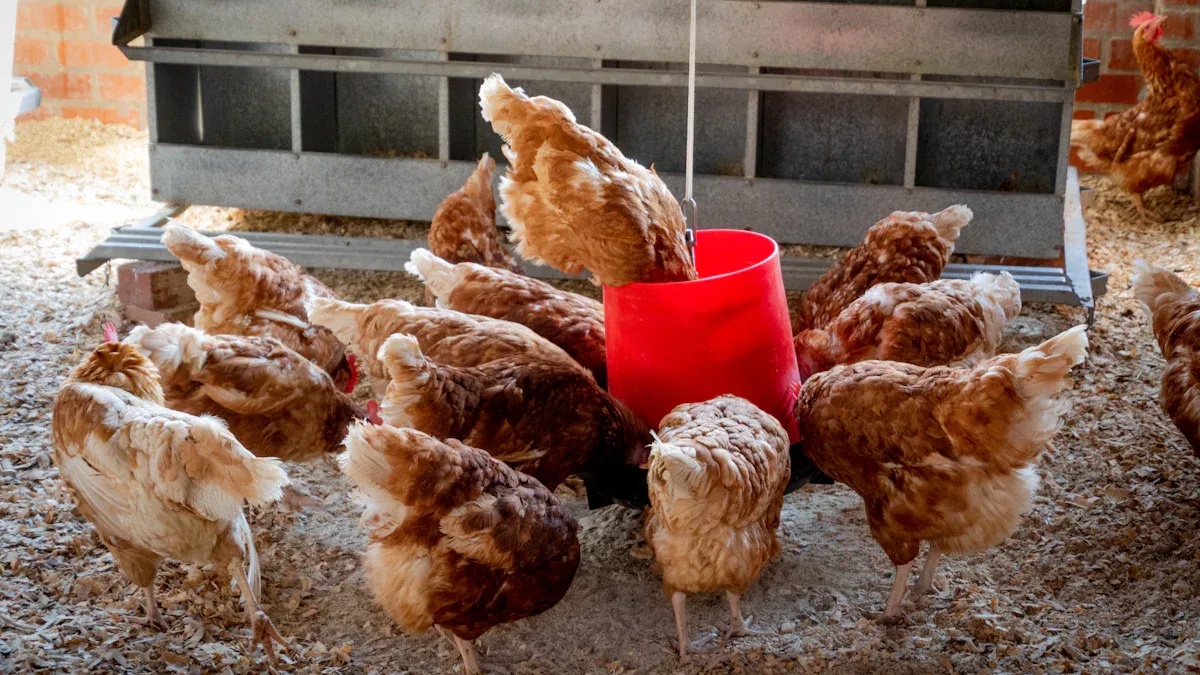
Mealworms in chicken feed have attracted attention for their rich protein and essential nutrients. Recent data show strong market growth:
| Year/Metric | Value |
|---|---|
| Market Value 2023 | USD 9.29 million |
| Projected Market Value 2032 | USD 17.66 million |
| Growth Rate (2024-2032) | 7.4% CAGR |
Farmers choose mealworms for better chicken health and eco-friendly production.
Key Takeaways
- Mealworms provide chickens with high-quality protein, essential amino acids, vitamins, and minerals that support growth, feather health, and egg production.
- Feeding mealworms improves chicken health by boosting immunity, encouraging natural foraging behavior, and enhancing egg quality without harming performance.
- Mealworm farming uses fewer resources and produces less environmental impact than traditional protein sources, making it a sustainable and cost-effective option for poultry feed.
Nutritional Benefits of Mealworms in Chicken Feed
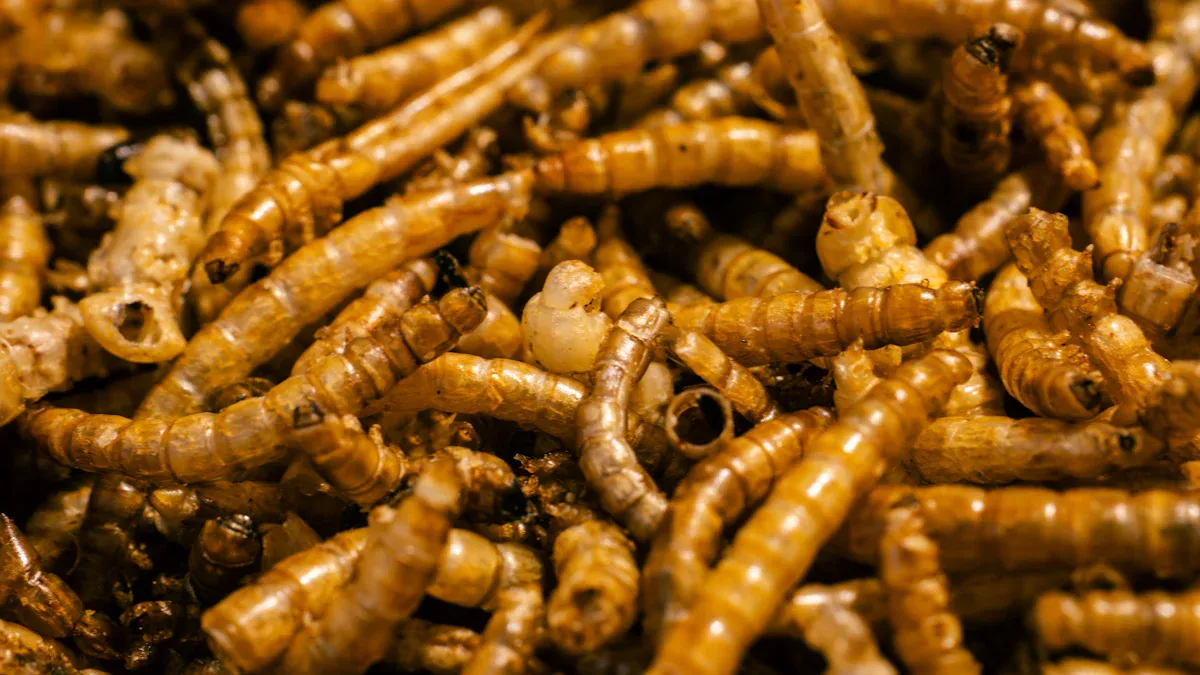
High Protein and Amino Acid Profile
Mealworms in chicken feed provide a powerful source of protein. Their protein content ranges from 45% to 54% on a dry matter basis, which is higher than many traditional feed ingredients. Chickens need protein for muscle growth, egg production, and feather health. The protein quality in mealworms is excellent, especially in essential amino acids. These amino acids, such as methionine, lysine, leucine, and isoleucine, are vital for healthy chickens. Methionine, in particular, is present at levels that even exceed those found in fishmeal and soybean meal.
Tip: Mealworms are not just high in protein—they also offer a complete amino acid profile, making them a superior choice for supporting chicken growth and productivity.
The following table compares the protein content of mealworms with other common feed ingredients:
| Diet Type / Feed Protein Content | Mealworm Protein Content (Dry Matter %) |
|---|---|
| Wheat bran (20.4% CP) | 47.9% |
| Wheat bran + Rye (20.4% CP) | 50.9% |
| Wheat bran + Fungi (20.2% CP) | 53.4% |
| Wheat bran + Soybean meal (17.5% CP) | 52.0% |
Mealworms also contain all the essential amino acids chickens need. The table below shows how mealworm meal compares to fishmeal in amino acid content:
| Essential Amino Acid | Fishmeal (Control) | Mealworm Meal (100% DMM) |
|---|---|---|
| Threonine | 1.64 | 1.57 |
| Valine | 2.17 | 2.39 |
| Methionine | 1.43 | 1.21 |
| Isoleucine | 2.03 | 2.02 |
| Leucine | 3.64 | 3.61 |
| Phenylalanine | 2.02 | 2.01 |
| Lysine | 3.78 | 3.43 |
| Histidine | 0.99 | 1.12 |
| Arginine | 2.52 | 2.41 |
| Tryptophan | 0.46 | 0.46 |
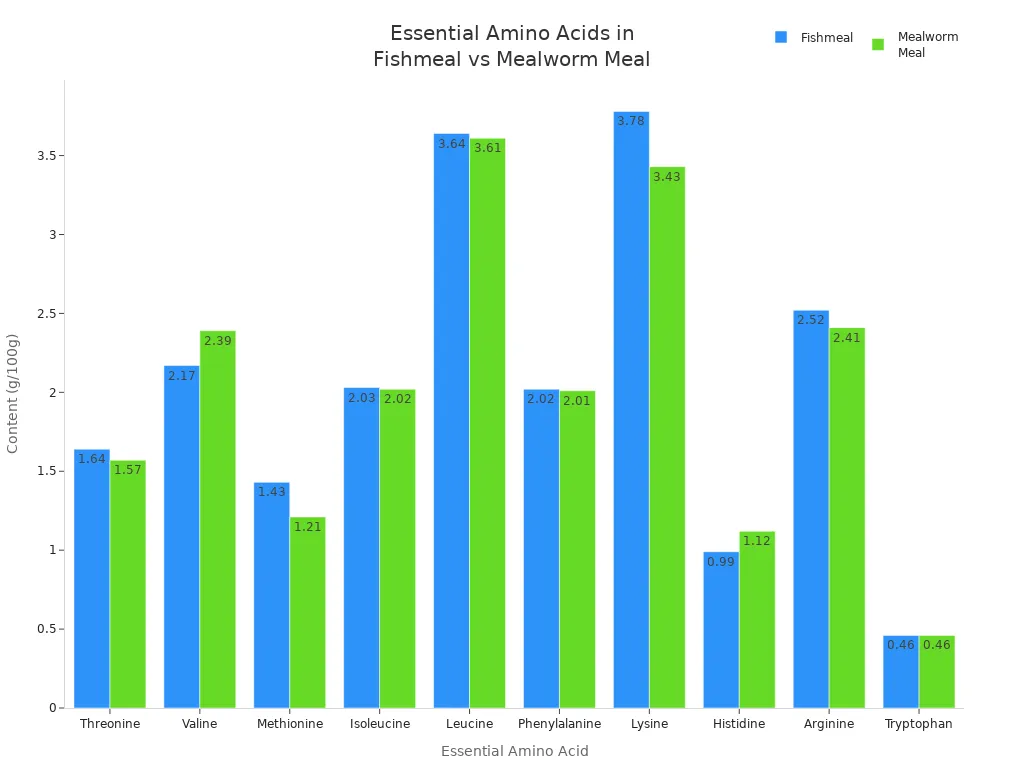
Rich Source of Vitamins and Minerals
Mealworms in chicken feed supply important vitamins and minerals that support chicken health. They are rich in B vitamins, especially B12 and B2, which help chickens turn food into energy. These vitamins are essential for growth and egg production. Mealworms also provide minerals such as iron, calcium, magnesium, and zinc. Iron supports healthy blood, while calcium and magnesium help build strong bones and eggshells.
The table below highlights the mineral content of mealworms per 100 grams dry matter:
| Mineral | Concentration (mg/100 g DM) | Notes |
|---|---|---|
| Calcium (Ca) | Up to 79 | Highest with fermented chicory roots |
| Iron (Fe) | Significantly increased | Up to 100 times higher in feed reflected |
| Manganese (Mn) | Increased with fermented chicory roots | Comparable to control feed |
| Magnesium (Mg) | Variable, low in mealworms | Related to feed Mg content |
| Zinc (Zn) | Increased with fermented chicory roots |
Mealworms also contain micro-minerals like copper and phosphorus. These nutrients help chickens develop strong bones and healthy immune systems. When chickens eat mealworms, they receive a boost in both macro and micro-nutrients, which can improve their overall health and productivity.
Note: For best results, some farmers feed mealworms a calcium-enriched diet before offering them to chickens. This helps balance the calcium-to-phosphorus ratio, which is important for laying hens.
Superior Digestibility for Chickens
Mealworms are easy for chickens to digest. Their nutrients become available quickly, which means chickens can use the protein, fat, and minerals more efficiently. Studies show that the digestibility coefficient for dry matter in mealworm-based diets reaches 96.26%. This is much higher than many other protein sources.
| Nutrient Digestibility Coefficient | Mealworms (%) | Poultry Viscera (%) | Poultry By-product Meal (PBPM) (%) |
|---|---|---|---|
| Dry Matter | 96.26 | 77.29 | 86.76 |
| Crude Fat | 94.78 | 98.15 | 84.64 |
| Crude Protein | ~77 | ~77 | ~77 |
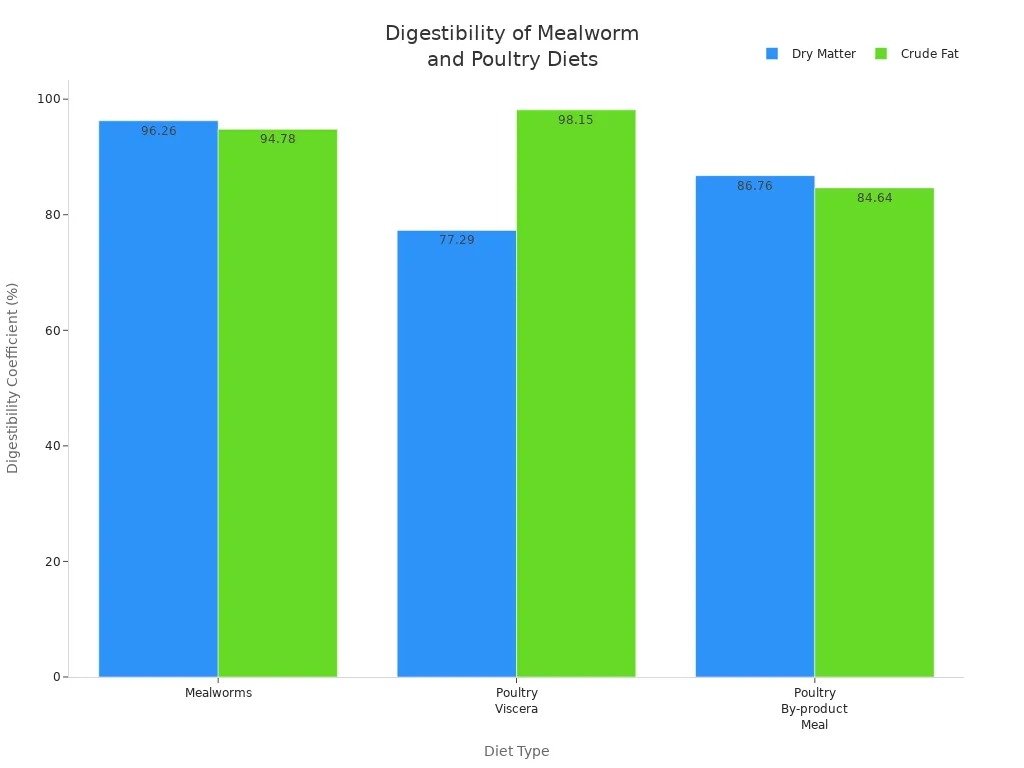
Chickens benefit from this high digestibility. They absorb more nutrients from mealworms, which leads to better growth, stronger feathers, and improved egg production. Many poultry keepers use mealworms as a healthy treat to support their flock, especially during molting or periods of high egg production.
Tip: Mealworms are a favorite treat for chickens. They not only provide nutrition but also encourage natural foraging behavior, making them a practical addition to any poultry diet.
Health and Productivity Advantages
Enhanced Growth and Feather Development
Mealworms in chicken feed support rapid growth and healthy feather development in poultry. Chickens need high-quality protein and a balanced amino acid profile to build muscle and grow strong feathers. Mealworms provide both. Studies show that adding mealworm meal to broiler diets leads to steady increases in daily weight gain and final body weight. Researchers found that replacing part of the soybean meal with mealworm meal improved growth rates and feed efficiency. The positive effects come from the superior digestibility and energy content of mealworms compared to plant proteins.
- Broilers fed mealworm meal gained more weight each day.
- Feed conversion ratios improved, meaning chickens used their feed more efficiently.
- Growth benefits appeared at inclusion levels up to 15%, with the best results at moderate doses.
- Some studies also reported better carcass characteristics.
Chickens also need extra protein during molting, when they lose and regrow feathers. Mealworms provide the nutrients needed for strong, shiny feathers. Many poultry keepers use mealworms as a treat during this time to help their birds recover quickly.
Tip: Mealworms are a favorite treat for chickens and can be used to encourage healthy feather regrowth, especially during molting.
Improved Egg Production and Quality
Mealworms in chicken feed can help hens lay more eggs and improve egg quality. A controlled feeding trial with laying hens showed that adding mealworm meal to their diet did not reduce egg production. Instead, it enhanced several important egg quality traits.
| Parameter | Effect of Mealworm Inclusion |
|---|---|
| Egg production (laying performance) | No negative effect; hens maintained production |
| Yolk color | Became richer and more vibrant with higher mealworm levels |
| Yolk histidine concentration | Increased with more mealworm meal |
| Fatty acid profile changes | Higher levels of healthy fatty acids in yolk |
| Total polyunsaturated fatty acids | Increased with mealworm meal |
Hens that ate mealworms produced eggs with deeper yolk color and a better fatty acid profile. The yolks contained more healthy fats, such as oleic and linoleic acids. These changes make the eggs more nutritious for people. The study also found that mealworm meal did not harm eggshell strength or overall egg quality.
Note: Mealworms can be used as a supplement to boost egg quality, making eggs more appealing and nutritious.
Boosted Immunity and Disease Resistance
Mealworms help chickens stay healthy by supporting their immune systems. Chickens that eat mealworm meal show stronger immune responses and better resistance to disease. Researchers found that broilers fed mealworm meal had lower mortality rates and higher levels of important immune proteins, such as immunoglobulins. Mealworms contain chitin and antimicrobial peptides, which help fight harmful bacteria in the gut.
- Chickens fed mealworm meal had increased levels of IgA and IgG, which protect against infections.
- The gut microbiome improved, leading to better digestion and stronger immunity.
- Mealworm-fed chickens survived disease challenges better and had fewer harmful bacteria in their organs.
- Immune system markers, such as interferon-gamma and interleukin-2, increased, helping the birds fight viruses.
Mealworms also support gut health, which is closely linked to the immune system. Healthier guts mean chickens can absorb more nutrients and resist illness more effectively.
Supports Natural Foraging Behavior
Mealworms encourage chickens to act naturally and stay active. Chickens love to search for mealworms, which stimulates their instinct to forage. When poultry keepers scatter mealworms in the yard or coop, chickens peck, scratch, and explore their environment. This activity keeps them engaged and reduces boredom.
Studies show that chickens given mealworms as enrichment display more natural behaviors, such as stretching, wing flapping, and ground pecking. These behaviors improve their welfare and reduce stress. Importantly, increased activity from foraging does not harm their health or physical condition.
Chickens that forage for mealworms stay active and happy. This enrichment supports both their physical and mental well-being.
Sustainability and Environmental Impact of Mealworms in Chicken Feed

Efficient Resource Utilization
Mealworm farming uses resources more efficiently than many traditional protein sources. Mealworms grow quickly and multiply in small spaces. Farmers do not need arable land to raise them. Mealworms can turn low-quality organic matter into high-quality protein and fat. This makes them a smart choice for sustainable farming.
| Protein Source | Land Required (m²/kg) | Water Required (m³/kg) | Notes |
|---|---|---|---|
| Mealworms | 3.07 | 4.341 | Use about one tenth the land of beef; water use much lower than livestock |
| Beef | ~30+ | Much higher | Highest land and water use |
| Pork | Higher than mealworms | Higher than mealworms | More emissions and resource use than mealworms |
Mealworms can be farmed vertically, which saves space and increases efficiency.
Waste Reduction and Circular Economy
Mealworms help reduce agricultural waste. They eat by-products like wheat bran and brewer’s spent grain. Farmers can recycle these materials by feeding them to mealworms. The mealworms then become a protein-rich feed for chickens. This process supports a circular economy by turning waste into valuable resources.
Urban farms use mealworms to manage organic waste. Some systems use sensors and automation to improve efficiency. In these systems, mealworms convert food waste into protein, and their frass (waste) can be used as fertilizer. This creates a closed-loop system that reduces the need for synthetic fertilizers and lowers environmental impact.
Lower Carbon and Environmental Footprint
Mealworm production creates fewer greenhouse gases than many animal proteins. Mealworms emit about 1.47 kg of CO2 per kilogram, which is less than fishmeal but more than soybean meal. Compared to beef and pork, mealworms have a much smaller carbon footprint. Scientific studies show that mealworm-based chicken feed lowers overall environmental impact, especially when mealworms are raised on organic waste.

Mealworms offer a sustainable protein source for chickens, helping farmers reduce waste and protect the environment.
Economic and Practical Considerations
Cost-Effectiveness Compared to Other Protein Sources
Mealworms offer a competitive option for poultry farmers looking to optimize feed costs and efficiency. Their high protein content and efficient feed conversion make them valuable in modern chicken diets. The table below compares feed conversion ratios (FCR) and protein efficiency ratios (PER) for different protein sources:
| Protein Source | Feed Conversion Ratio (FCR) | Protein Efficiency Ratio (PER) | Notes on Growth and Efficiency |
|---|---|---|---|
| Wheat Bran (Traditional) | ~1.8 – 3.7 | Highest PER ~3.6 | Most efficient protein utilization; best larval growth |
| Pea Protein (High Protein Legume) | Up to 3.7 | Low PER 0.6 – 1.8 | Higher FCR, lower efficiency; inhibits larval growth |
| Rice Protein (High Protein) | ~2.8 | PER 1.1 – 2.3 | Better growth and feed conversion than pea protein |
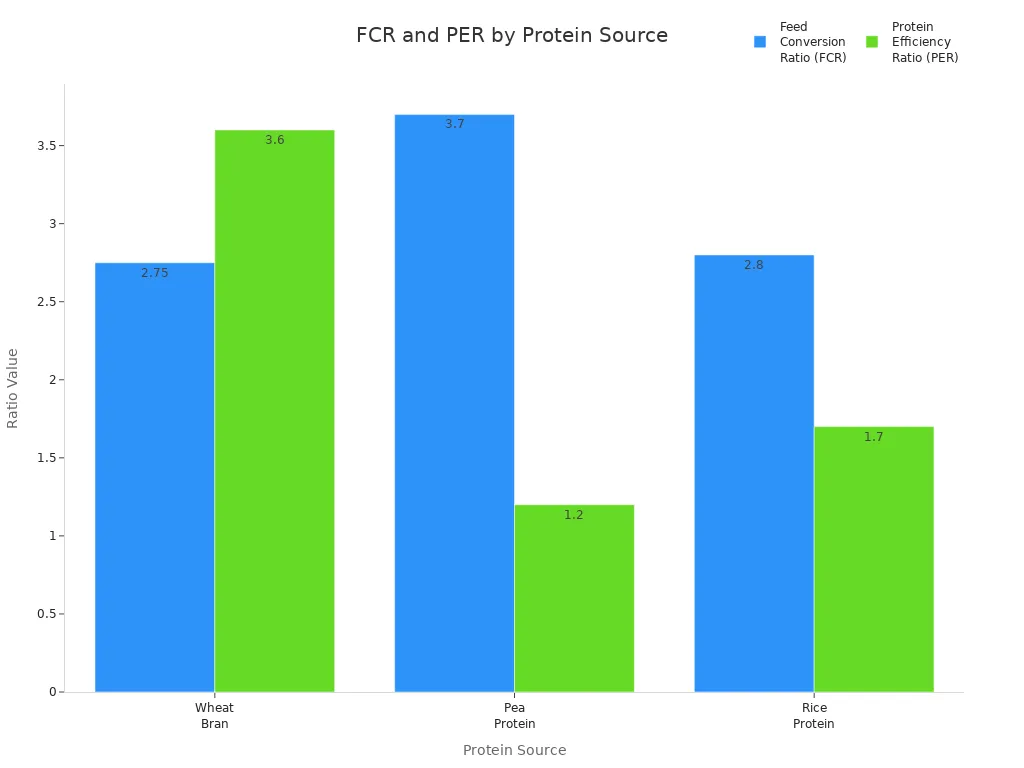
Mealworms can partially replace traditional protein sources like soybean meal, helping farmers manage feed budgets while supporting chicken growth.
Ease of Integration into Chicken Diets
Farmers have found mealworms easy to add to commercial chicken diets. Mealworms work well as a partial replacement for soybean meal and oil. Their rich protein and energy content support healthy growth and immune function. Most poultry keepers report that chickens readily accept mealworms, making them a practical choice for both backyard and commercial flocks.
Chickens enjoy mealworms, which encourages natural foraging and active behavior.
Feeding Guidelines and Moderation
Poultry nutrition experts recommend including mealworm meal at moderate levels for best results. For broilers, diets with 2% to 5% mealworm meal improve growth and feed efficiency. Layers can benefit from inclusion rates above 5% to enhance egg production. Studies show that higher levels do not provide extra benefits and may reduce performance. Farmers should always feed mealworms as part of a balanced diet to ensure optimal chicken health.
Tip: Start with small amounts and observe flock response before increasing mealworm inclusion in feed.
Mealworms in Chicken Feed vs. Traditional Protein Sources
Comparison with Soybean Meal
Mealworms and soybean meal both serve as important protein sources for chickens. Their protein content is similar, but mealworms offer higher fat and fiber. The fat in mealworms contains healthy unsaturated oils, which support energy needs and feather health. Mealworms also provide chitin, a special fiber that helps gut health and boosts immunity. Soybean meal contains more carbohydrates and a different amino acid profile. The table below highlights key differences:
| Nutrient / Feature | Mealworms (Dry Weight) | Soybean Meal (Dry Weight) |
|---|---|---|
| Protein | ~53% | 49-56% |
| Fat | ~28% (mostly unsaturated) | Lower fat |
| Fiber | ~6% (chitin) | 3-5% |
| Carbohydrates | None | Present |
| Micronutrients | Magnesium, zinc, iron | Molybdenum, manganese |
Mealworms provide extra fat and fiber, which soybean meal lacks.
Comparison with Fishmeal
Fishmeal has long been a premium protein source in poultry diets. Mealworms match fishmeal in protein quality and essential amino acids. Both support strong growth and egg production. However, mealworms contain less fishy odor and taste, making them more appealing to chickens and farmers. Mealworms also avoid the risk of overfishing and marine pollution.
Digestibility and Nutrient Absorption
Chickens digest mealworms and soybean meal with similar efficiency. Mealworms offer high protein digestibility and quick nutrient absorption. The chitin in mealworms acts as a prebiotic, supporting gut health and immune function. Soybean meal does not provide this benefit. Chickens absorb more healthy fats from mealworms, which helps with energy and feather growth.
Environmental Impact Differences
Mealworm farming uses less land and water than soybean or fishmeal production. Mealworms grow quickly and thrive on organic waste, reducing the need for new resources. Fishmeal production can harm ocean ecosystems, while soybean farming often leads to deforestation. Mealworms offer a more sustainable choice for modern chicken nutrition.
Addressing Common Questions and Concerns
Safety and Quality Assurance
Farmers and poultry keepers often ask about the safety of mealworms in chicken feed. Reputable producers raise mealworms in clean, controlled environments. They monitor for contaminants and ensure the mealworms meet strict quality standards. Regular testing checks for bacteria, heavy metals, and pesticides. This process helps protect both chickens and people who eat their eggs or meat.
Chickens digest mealworms easily. Mealworms do not introduce harmful substances when sourced from trusted suppliers.
Recommended Inclusion Rates
Experts suggest adding mealworms to chicken diets in moderation. For broilers, 2% to 5% of the total feed works well. Laying hens benefit from slightly higher rates, usually above 5%. Farmers should always balance mealworms with other feed ingredients. This approach ensures chickens get all the nutrients they need for growth, egg production, and feather health.
- Start with small amounts.
- Watch how chickens respond.
- Adjust the amount as needed.
Consumer Perception and Acceptance
Consumers want to know if eggs and meat from chickens fed with mealworms are safe and appealing. Studies show that many people accept insect-fed chicken products, especially when they understand the benefits. A survey of university students in South Africa found the following:
| Aspect Evaluated | Key Findings |
|---|---|
| Familiarity with Insect Feed | 54% familiar with insects as chicken feed. |
| Positive Perception of Insect-fed Meat | 46% had a positive perception. |
| Neutral Perception | 28% were neutral. |
| Concern about Allergic Reactions | 28% expressed concern. |
| Disagreement on Allergy Concern | 47% disagreed or strongly disagreed that insect-fed meat causes allergies. |
| Consumer Attitude | Most focus on meat quality and price; education improves acceptance. |

Education helps increase acceptance. Most consumers care more about quality and price than the type of feed used.
Mealworms in chicken feed provide nutrition, sustainability, and practical benefits for poultry keepers. Experts predict strong growth in this market:
- Mealworms require fewer resources than soybeans or fishmeal.
- Innovations in farming technology improve efficiency.
- Poultry farming remains a key sector for sustainable protein alternatives.
FAQ
Are mealworms safe for chickens to eat?
Farmers can safely feed mealworms to chickens. Reputable producers raise mealworms in clean environments and test for contaminants.
How often should chickens eat mealworms?
Chickens benefit from mealworms as a treat. Most experts recommend feeding mealworms two or three times per week.
Do mealworms improve egg quality?
- Mealworms provide protein and healthy fats.
- Hens that eat mealworms often lay eggs with richer yolks and stronger shells.


